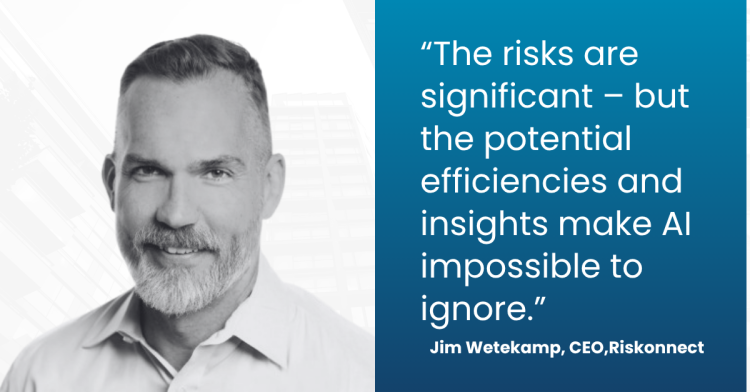How AI is reshaping risk management: the opportunities, risks and where to use it

AI is changing so fast, it’s hard to know when it should be used, where to use it and how to make sure it is used safely. The risks are significant – but the potential efficiencies and insights make AI impossible to ignore. Jim Wetekamp, CEO of Riskonnect, explains.
AI can greatly enhance your risk management efforts – if implemented wisely. According to Riskonnect’s new survey, The 2025 New Generation of Risk Report, nearly 60% of companies are considering forging ahead with leading-edge agentic AI (which can independently make decisions and execute tasks without human involvement). Yet just 27% have formally assessed the accompanying risks.
The lack of risk management over agentic – or any form of – AI is reckless. Without oversight and strong governance policies, it will be a struggle to safely adapt to AI’s constant evolution.
AI is a tool. And like any tool, its value depends on how you use it. What are you trying to achieve? What objectives are you trying to accomplish? Are you mostly looking to speed up processes? Or are you looking to uncover new insights?
Impact on risks
AI will reduce risks to data accuracy and the risk management process with automation. And with its ability to instantly ingest massive amounts of information, AI can help you understand risk at a deeper level to guide strategy.
However, AI adds other risks that need to be checked, such as:
Hallucinations. The technology is known to occasionally answer questions with made-up information.
Bias. Generative AI uses historical information to build new content. However, what was considered acceptable a decade ago may not be today.
Data privacy. Know what the model is trained on and how your data will be used. Large language models like ChatGPT capture everything in your prompt and incorporate it back into the model. Be aware of what information you are sharing outside your organisation to prevent proprietary knowledge ending up in your competitors’ hands.
Impact on people
Will AI replace you? That depends. Like any new technological advancement, AI will mean the end of some jobs, and the creation of others.
AI can perform administrative tasks better than humans. It can also analyse vast amounts of structured and unstructured data, find patterns and devise solutions faster than any human.
But you can’t automatically accept its output as the final word. Humans will continue to be needed to review, validate and refine the answers that AI generates. And humans are the ones to interpret and apply the insights discovered by AI.
Consider AI output as a starting point, a base on which to build more knowledge or think differently about an issue. It’s up to the people working with AI to bring their best human thinking qualities to refine the substance, tone and voice to fit the organisation.
In most cases, AI will likely add up to more of a redistribution or retraining of talent rather than a job killer. Those who were doing jobs that are better performed by AI may welcome the opportunity to apply their knowledge and thinking power to a greater use.
Where to use AI in risk management
With AI’s ability to make sense of large amounts of information in any format, find insights at lightning speed and translate technical information into everyday language, it’s not surprising that more and more companies are incorporating AI into the way risk is managed.
Nearly 70% of Riskonnect survey respondents report using AI to manage risk in some capacity, up from 62% one year ago. The top ways risk leaders are leveraging AI are:
-
Assessing risks (34%)
-
Risk forecasting (28%)
-
Scenario planning and simulations (28%)
-
Creating risk registers (28%)
-
Surfacing risks that were not previously considered (28%)
Of note, however, only 12% of companies surveyed say they feel prepared to assess, manage and recover from AI and AI governance risks. While this is up from preparedness levels in past years (9% in 2023 and 8% in 2024), it is still low. As companies rush to deploy AI, this is a dangerous place to be.
Don’t wait
With AI technology moving at breakneck speed, it can be hard to decide on the right time to jump in. To be sure, there are many uncertainties, and you may feel inclined to wait until you know more before committing to the technology.
Yet you run an even larger risk by failing to integrate AI into your risk management processes now. The competitive edge will go to those that tap into the power of AI the fastest.
Used properly – with the right people, processes and governance – AI can be an unparalleled business asset. You’ll run more efficiently by having it handle routine tasks. You’ll operate more effectively by freeing up resources to better analyse, monitor and respond to risks. And you’ll be more agile, ready to take advantage of new business opportunities.
Jim Wetekamp is the CEO of Riskonnect, a global leader in integrated risk management solutions. With expertise in helping organisations navigate complex risk landscapes, Wetekamp is passionate about empowering businesses to build resilience and thrive in an ever-changing world.
